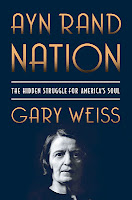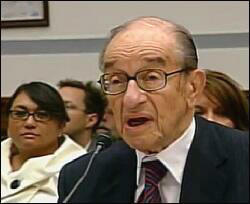By Pam Martens and Russ Martens: April 21, 2015
 On October 23, 2008, with much of Wall Street lying in ruins and the U.S. economy rapidly heading toward a 1930s type of collapse, Henry Waxman, Chair of the House of Representatives’ Oversight Committee, attempted to elicit answers from Alan Greenspan, the former Chair of the Federal Reserve for an unprecedented 18 years who had pushed for the deregulation of Wall Street that had left the country teetering.
On October 23, 2008, with much of Wall Street lying in ruins and the U.S. economy rapidly heading toward a 1930s type of collapse, Henry Waxman, Chair of the House of Representatives’ Oversight Committee, attempted to elicit answers from Alan Greenspan, the former Chair of the Federal Reserve for an unprecedented 18 years who had pushed for the deregulation of Wall Street that had left the country teetering.
After enumerating a series of recent financial collapses occurring from either deregulation or corrupted business principles, Waxman said:
“Each of these case studies is different, but they share common themes. In each case, corporate excess and greed enriched company executives at enormous cost to shareholders and our economy. In each case, these abuses could have been prevented if Federal regulators had paid more attention and intervened with responsible regulations.”
In those three sentences, Waxman had correctly indicted a lifetime of writing and theories espoused by Ayn Rand and her acolyte, Alan Greenspan. Rand’s theory is simpleminded and destructive – on both the personal and societal level. It holds that the selfish desires of the individual should have no restraints by government; the poor deserve their lot and should receive no tax support from other citizens while the rich have a right to unrestricted power.

Alan Greenspan, Former Fed Chairman, Testifying to the House Oversight Committee on How He Got It Wrong, October 23, 2008
Greenspan not only worshiped at the feet of Rand but wrote essays for her “Objectivist” newsletter and contributed articles for her book Capitalism: The Unknown Ideal. One of Greenspan’s articles in the book is titled “Antitrust.” Greenspan makes the same simplistic and deluded case as Rand that if government will only get out of the way, corporate leaders will move the country forward. Greenspan writes:
“The churning of a nation’s capital, in a fully free economy, would be continuously pushing capital into profitable areas — and this would effectively control the competitive price and production policies of business firms, making a coercive monopoly impossible to maintain…To sum up: The entire structure of antitrust statutes in this country is a jumble of economic irrationality and ignorance. It is the product: (a) of a gross misinterpretation of history, and (b) of rather naive, and certainly unrealistic, economic theories…No speculation, however, is required to assess the injustice and the damage to the careers, reputations, and lives of business executives jailed under the antitrust laws.” At the end of this treatise, Greenspan writes, “I am indebted to Ayn Rand for her identification of this principle.”
In addition to writing for Rand, Greenspan was a member of her “Collective” in New York City. Gary Weiss wrote about the “Collective” in his book Ayn Rand Nation: The Hidden Struggle for America’s Soul. According to Weiss, “For much of its existence the Collective was for all intents and purposes a cult. It had an unquestioned leader, it demanded absolute loyalty, it intruded into the personal lives of its members, it had its own rote expressions and catchphrases, it expelled transgressors for deviation from accepted norms, and expellees were ‘fair game’ for vicious personal attacks.”
At the October 2008 Congressional hearing, when Congressman Waxman was finally able to get Greenspan to address how he had been blindsided to the craven corruption building right under his nose, leading to an epic collapse of the economy and Wall Street in 2008, Greenspan replied:
“So the problem here is something which looked to be a very solid edifice, and, indeed, a critical pillar to market competition and free markets, did break down. And I think that, as I said, shocked me. I still do not fully understand why it happened and, obviously, to the extent that I figure out where it happened and why, I will change my views. If the facts change, I will change.”
After leaving the Fed, Greenspan went on to collect large fees as an adviser to John Paulson’s hedge fund, the epitome of selfish pursuit and greed. Greenspan’s successor at the Fed, Ben Bernanke, has recently announced he will be joining a hedge fund as well, Citadel.
Rand was not only a subpar thinker and writer but a fake as well. She vilified government welfare programs but collected Social Security. She wrote copious odes to the inherent morality of the intellectual elite, then had an extra-marital affair with a younger man in her employ. She abhorred government intrusions, but testified willingly before the House Un-American Activities Committee in 1947 about communist intrusions into Hollywood.
As for the caliber of her writing, in 2012 Harold Bloom, Sterling Professor of the Humanities and English at Yale University replied to my email query that: “Ayn Rand was a writer of no value whatsoever, whether aesthetic or intellectual. The Tea Party deserves her, but the rest of us do not. It is not less than obscene that any educational institution that relies even in part on public funds should ask students to consider her work. We are threatened these days by vicious mindlessness and this is one of its manifestations.”
Professor Bloom was likely referring to revelations at the time that corporate money was contractually mandating the reading and teaching of Rand at publicly funded universities.
Both Rand and Greenspan had early ties to corporate front groups. In the 1930s, Rand wrote a novella that was eventually published in the U.S. in 1946 under the title, Anthem, by a corporate front group. In recent years, Anthem has been pumped into high schools across the U.S. and Canada with financial inducements to both teachers and students by a corporate funded nonprofit tied to hedge funds. The book presents a frightening dystopian world engineered by an out of control government.
On February 13, 1946, Rand wrote to Leonard Read, suggesting that he arrange for the publishing of Anthem. Read had become the head of the western division of the U.S. Chamber of Commerce in the 1930s and assumed the leadership of the Los Angeles branch and its 10,000 members in 1939. In the letter to Read, Rand explains:
“I don’t want to issue ANTHEM as a regular book now, because it is only a novelette and not big enough to follow THE FOUNTAINHEAD. But when you asked, in your letter: ‘Why don’t we get it published?’ – did you mean as a pamphlet – specifically by The Pamphleteers? I think that might be a very good idea – if a fiction story fits in with The Pamphleteers’ program. Perhaps you might even be able to arrange to sell it, as a pamphlet, in bookstores and, if so, might get quite a large sale on the strength of my following.”
The Pamphleteers published Anthem in 1946. In the book, Invisible Hands: The Businessmen’s Crusade Against the New Deal, Kim Phillips-Fein writes that another notable event happened in 1946. Read reached out to David Goodrich, President of the B.F. Goodrich Company, and the first free market think tank in the post-war period was founded: the Foundation for Economic Education (FEE).
According to Fein, initial funding of $10,000 each came from ConEd, General Motors, U.S. Steel and Chrysler. Many of the same individuals involved in The Pamphleteers were involved in the Foundation.
According to Jennifer Louise Burns in her book, Goddess of the Market: Ayn Rand and the American Right, 1930 – 1980, “Read tapped Rand to serve as FEE’s ‘ghost,’ asking her to read material he intended to publish to make sure it was ideologically coherent.” Rand also submitted her own prospective writings to Read to review and referred to herself in correspondence to him as FEE’s “ghost.”
FEE is still very much alive and has been charged by Greenpeace with being one of the climate denial front groups.
One of Greenspan’s earliest jobs was at the National Industrial Conference Board (NICB), today known simply as The Conference Board. NICB was created with corporate money in 1916 to counter the devastating negative publicity that grew out of the Triangle Shirtwaist Factory fire where children and women were burned to death in a New York City sweatshop and the Ludlow Massacre in which a tent colony of striking miners and their families were attacked by the National Guard, leaving women and children dead along with striking miners.
Despite the devastating hubris this twosome has wrought on the United States, our Nation’s students are still being force fed this rot through corporate money lurking behind the dark curtains of nonprofits.

